Launch Your Lead Generation with the Facebook Ads Two-Step
Organizing your Facebook Ad campaigns with this proven framework will improve your audience targeting, contextualize your ad creative, and allow for better tracking of results.
Get a Free Marketing Analysis and Consultation
Nowspeed can review your Website, SEO, PPC, Email or Social Media Campaigns and identify ways to make an immediate impact!
The Facebook Ads Two-Step is a method that we use at Nowspeed to generate results for our clients, but pretty much every advanced Facebook advertiser is using some form of this method. If you want to advertise like the pros, you’re in the right place.
And that’s not some kind of weird flex. For experienced advertisers, the Facebook Ads Two-Step, as we call it, is simply the way things are done.
All advanced Facebook advertisers use some form of this framework.
Prefer to watch this training on video? Download the recorded webinar.
And yet a significant number of businesses miss out on leads due to poor ad performance by not using the Facebook Ads Two-Step framework.
That’s right, this is a framework, not a tactic. This post isn’t necessarily going to teach you exactly what to write in terms of ad copy, exactly what length of video to use, or exactly who you should target. It’s impossible to recommend any of those details without first looking at your business.
Instead, what I’m going to show you today is a framework where you can fill in the gaps with your own unique business strengths and the things that make you different from competitors.. If your current Facebook ad campaigns aren’t performing and you’re not sure why, this post will help you uncover the reason for poor performance and help you improve going forward.
That said, the first thing that you’re going to need before we can actually start two-stepping is a solid technical foundation.
And when we’re talking about Facebook ads, a solid technical foundation means proper implementation of the Facebook Pixel.
The Facebook Pixel is what allows you to do all the juicy parts of Facebook ads like track conversions, run retargeting ads, and a lot of stuff you will need to succeed.
If you don’t have your pixel configured properly…
- You won’t be able to Two-Step.
- You won’t be able to track conversions and cost per lead.
- You won’t be able to let Facebook’s algorithm optimize your ads over time the way all successful advertisers do.
For those three reasons, it’s really important that you install the Facebook pixel on your site and configure the events. And it’s actually not difficult at all.
Here is what you need to do to get a pixel-perfect website.
Install the Facebook Pixel globally on your site
You’re going to want to install the Facebook Pixel globally—on every page of your website—and fire the PageView event on every single page.
This includes the landing page that your ads point to. Firing a PageView event enables Facebook to keep a record of each time a Facebook user visits a page on your website.
![]()
*Note—In order to test and debug your Facebook Pixel, you’ll want to install the Facebook Pixel Helper browser extension for Google Chrome.
Fire the Facebook Lead Event on your thank-you page
You want to track when someone fills out and submits an online form. Can you harness the power of the Facebook pixel to do that? You sure can.
You should have a thank-you page on your website. This page loads after someone submits a form. Make sure to fire the Lead event on the thank-you page. Once the Lead event is enabled, Facebook Ads Manager will count any visits to the thank-you page as a lead.
![]()
Note the URL change and the pixel event. When reviewing your campaign data, you’ll be able to see how many leads your ads generated and what they cost.
There are plenty of different ways you can collect lead information, but this is the easiest and most effective way.
Pro-tip for thank-you pages: Note that if somebody makes it all the way through our funnel to the training video, we give them the option to schedule a call. You’ve already built the momentum with these ads and landing pages–why not capitalize on it when their interest level is high? This is more of a user experience thing than an advertising thing, but it’s still a great practice for landing pages.
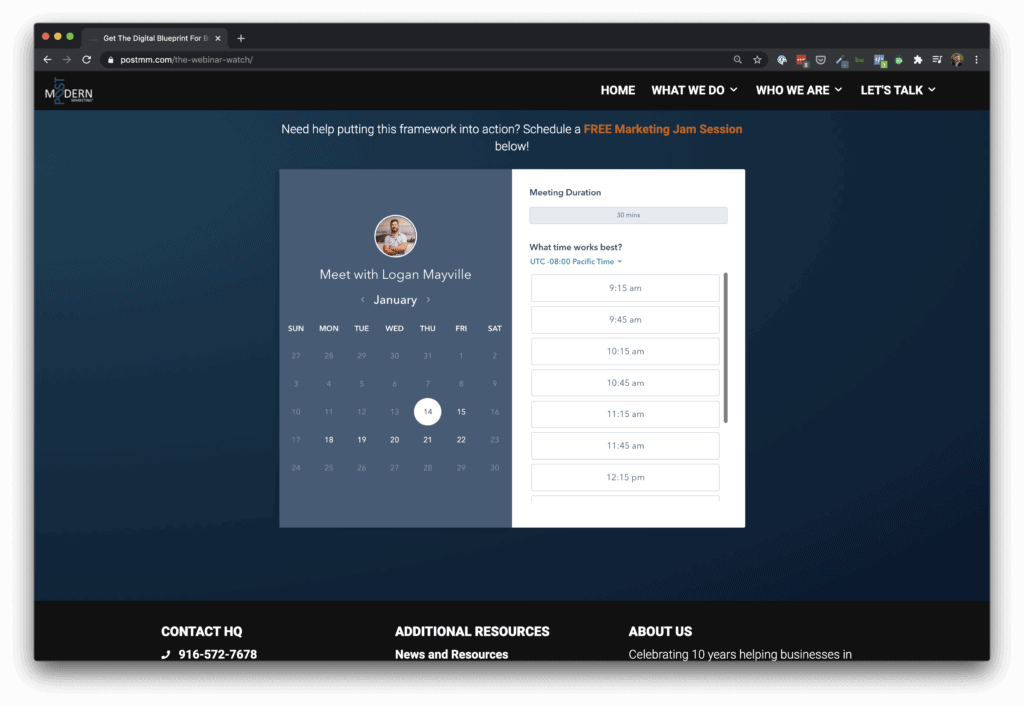
As you can see, it’s not hard to have a pixel-perfect website. It only takes a few minutes and there are plenty of resources online to help you figure it out.
Now that you have your funnel set up you can actually begin the Facebook Ads Two-Step!
What I want you to do right now is divide your brain into two sections.
One that thinks about prospecting and the other that thinks about retargeting.
Prospecting Facebook Ad Campaigns
“Prospecting” is a term that Facebook advertisers use to indicate the practice of targeting audiences that have not been on your website before, have not seen your videos before, and can generally be considered new to your brand. These are fresh audiences. Your ad is basically introducing them to your brand for the first time.
Some characteristics of prospecting audiences are:
- The audience size in Facebook Ads Manager should be over 150,000 people at a minimum.
- The goal of prospecting audiences is attention, interest, desire, and action in that order—AIDA for short. No one takes action if you don’t have their attention. We’ll take a look at some creative examples later.
- The metrics for success in prospecting campaigns are click-through rate, video watch percentage, and cost per acquisition, to name a few.
- Your prospecting campaigns should represent about 80% of your total budget. This gives you an adequate sample size, allowing you to test, innovate, and improve campaigns over time.
Retargeting Facebook Ad Campaigns
Now, on the other side of the coin, you have retargeting audiences. These are audiences who have been to your site, have watched some of your videos, or have engaged with your brand on Facebook or Instagram.
- These are going to be narrower audiences, a relatively small group of people.
- Your goal with a retargeting ad is to overcome any objections potential leads might have to your product or service, so they become a lead or actual customer.
- The metric for success for retargeting campaigns is just cost per acquisition. Other metrics don’t matter as much because it’s such a small audience.
- Retargeting audiences should represent about 10% to 20% of your budget.
So that’s the Facebook Ads Two-Step in theory, but now let’s take a look at what that looks like in practice.
If you’ve ever used Facebook Ads Manager, you know that your ad account is composed of campaigns, ad sets, and ads. You should always separate your prospecting campaigns from your retargeting campaigns. Never mix prospecting and retargeting audiences. If you do, you’ll never be able to tell which audience was responsible for your results.
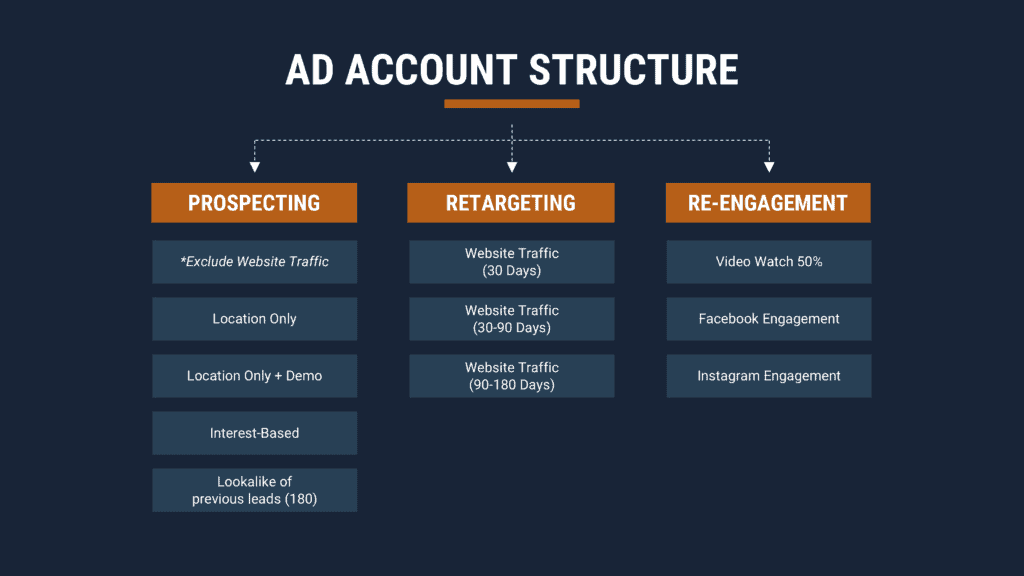
Here are some popular prospecting audiences:
- Interest-based audiences are probably the most widely used with Facebook ads.
- Location-only audiences—if you’re advertising locally and you have a small market.
- Demographic-based audiences if you’re advertising in a more densely populated area or for a specific niche (such as parents).
- Lookalike audiences can be really effective so long as you have a good source.
Some popular choices for retargeting audiences are:
- Website traffic from the last 30 days.
- Website traffic from the last 90 days.
- Website traffic from the last 180 days.
Re-engagement audiences are people that have engaged with your brand on Facebook or Instagram, either by liking, commenting, sharing, or saving your ads. I’ll often combine these with retargeting audiences into the same campaign, but I’ve separated them in the graphic above just so you can see some popular re-engagement audiences.
One of the beautiful things about separating your audiences like this is that you can actually tailor your ad creative to their specific stage in the buyer’s journey.
Ad Creative Examples for Prospecting Campaigns
Here’s an example of a prospecting ad that performed really well in the past. The absolute first thing you have got to do with a prospecting ad is stop the user from scrolling past.
Before we look at the ad below, remember what the ad is trying to achieve:
- Attention
- Interest
- Desire
- Action
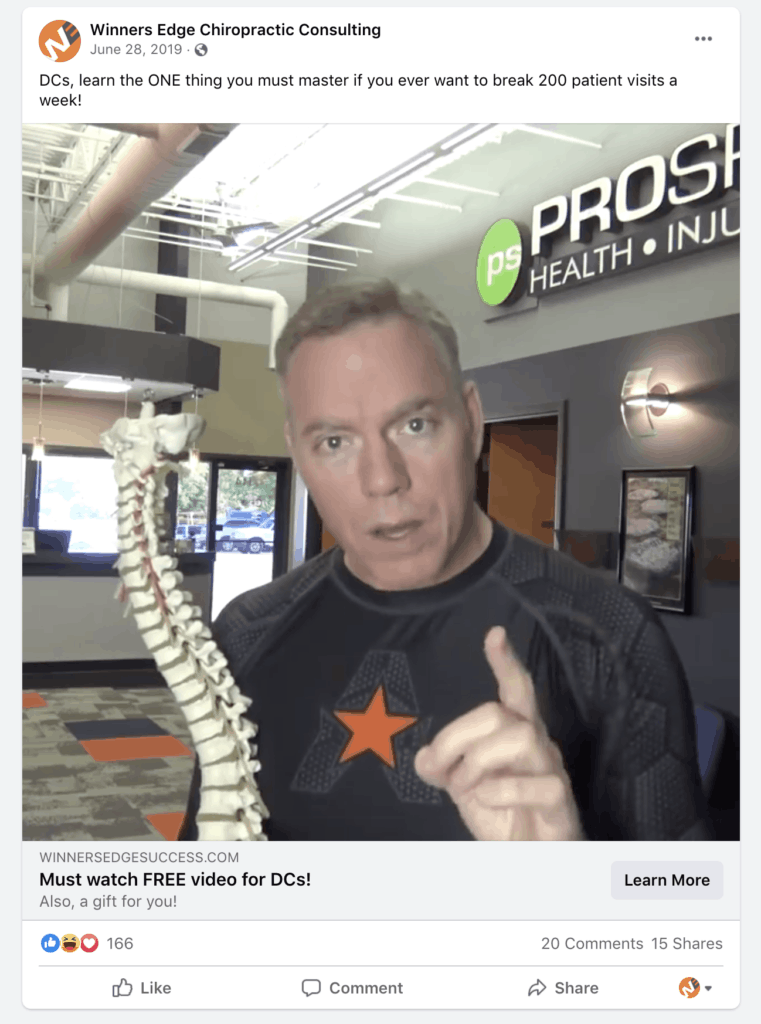
So here’s this guy and he’s got a kind of an odd shirt on and he’s holding a plastic spine… and for a specific type of audience, that’s going to grab their attention.
If you successfully stop their scroll, the next thing your audience will do is glance up at the primary text area, and that’s where you can build their interest level.
The copy on this ad reads:
DCS, learn the ONE thing you must master if you ever want to break 200 patient visits a week!
“DCs” is an industry term for a chiropractor; that’s how they refer to themselves. It’s not a consumer term. So what that means is this ad is directed at chiropractors and they’ll know he’s speaking to them because it’s an esoteric term.
A chiropractor can easily do a quick calculation of what 200 patient visits a week would do for them in terms of revenue. So basically what he’s talking about in cleverly coded language is business growth, but the numbers make it stand out.
Attention and interest have been achieved.
The headline reads it’s a “Must-watch free video for DCs.” This gives them a hint that on the other side of the click is a free video that will tell them how to grow their practice. Watching a video is a pretty low effort click for the user, so many will click on the ad.
Lastly, there’s a mention of a bonus gift in the link description, but they’ll have to click through to figure it out, which helps arouse curiosity. As you can see from the social proof and the engagement in the comments section, this was a really popular video.
But even if they liked the ad and actually clicked through, not everyone will convert right away. That’s just the nature of digital marketing. If that’s the case, then you have the retargeting campaign as the catcher’s mitt underneath everything trying to grab those leads who didn’t convert on the first ad.
Ad Creative Examples for Retargeting Campaigns
Here we have a woman giving a testimonial. The primary text area is a quote from the video talking about how great the program is.
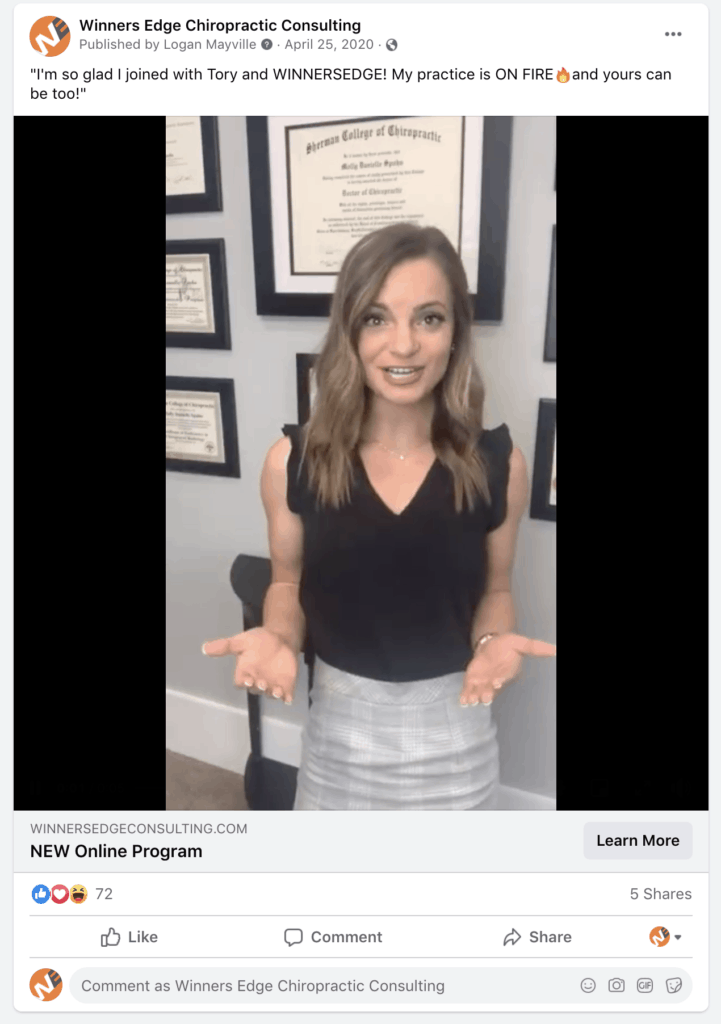
If this was in a prospecting campaign, it might’ve seemed a little out of place since the audience doesn’t even know what the program is about. This particular ad makes more sense if you’ve already been exposed to the offer and need a little persuasion to get you to convert into a lead.
Those are examples of how the Facebook Ads Two-Step can help you optimize your ad creative, but that’s not the only benefit to dividing your campaigns in this way.
The Benefits of Segmenting Your Facebook Ads Campaign Data
As I mentioned, you should never mix your prospecting and retargeting audiences because you’ll never be able to tell which audience was responsible for the result. But once you have your campaigns separated into these two groups you’re going to receive data on both campaigns, making it easier to decide how to allocate future ad spend and giving you a better idea of the type of ad copy that actually works.
In your prospecting campaigns, you’ll want to look closely at click-through rate and video watch percentage, making adjustments based on the data.. Low CTR in a prospecting campaign likely won’t work in the long term, so you’ll need to work on your ad creative—especially the primary text copy.
Additionally, if you discover that your retargeting campaigns are converting leads efficiently, it would make sense to feed your prospecting campaigns more budget so you can have a larger retargeting audience to increase the number of conversions.
This data will allow you to iterate and make better ads that increase performance over time.
If you’ve got the data, you can start to develop a testing mentality.
What to Test with Facebook Ads
A lot of people try Facebook ads. A lot of people quit Facebook ads. If the ads don’t perform right away, and the advertiser doesn’t know why the ads didn’t perform, they tend to assume the platform is just a bad fit.
But if you have this level of organization inside your Ads Manager, you can actually figure out why things didn’t work.
For example, was the click-through rate in your prospecting campaigns too low and not generating enough traffic? You’ll need to work on your ad creative, especially the copywriting.
Here are a few other things you can test.
Test Your Offer
The first thing you’ll actually want to test is your offer, which ironically, doesn’t have anything to do with Facebook ads. What are you offering this lead? Does your landing page convey what the offer is with the right messaging and call to action?
If your landing page is converting under 10% of the traffic it receives, it’s going to be very expensive no matter how good your ads are. If you’re converting above 20% of your traffic, that’s a home run and you should probably increase your ad spend.
Test Your Ad Creative
Obviously, you can—and should—test your ad creative. If your click-through rate is below 1%, you should make some changes to your ad copy. Aim for 1.5% percent and higher.
Test Your Audiences
Additionally, you can test your audiences. You can test lookalikes, you can test broad-based, location-only audiences, and many more.
Keep in mind: the Facebook Ads Two-Step is one part of a successful social media ad campaign.
In our Digital Blueprint for Business webinar, we lay out the three key areas that businesses need to focus on to ensure their digital marketing strategy will work. Look at the graphic below and you’ll see what we mean.
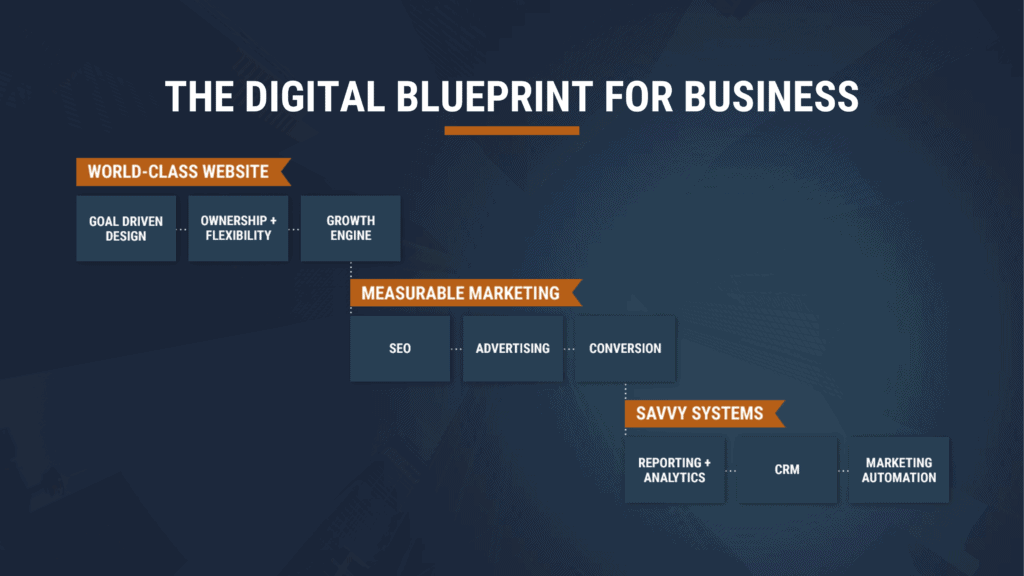
Facebook Ads Two-Step is going to fit in this advertising box as part of your Measurable Marketing initiative. But if you’re sending paid traffic to a website that’s not world-class, your conversion rates will be low and your campaigns will be very expensive—you’ll end up wasting a lot of money sending traffic to a site that’s not optimized.
And if you’re generating leads at an efficient rate, what systems do you have in place to turn them into customers? Do you have reporting and analytics to understand the costs and the outcomes of those? Do you have a CRM and marketing automation system where you can nurture those leads with emails that nudge them towards a purchase?
Facebook Ads Two-Step is only a small part of a comprehensive digital marketing strategy. You’re going to need all of this if you want to have long-term success.
If you’re interested in seeing how the Facebook Ads Two-Step fits into the bigger picture of digital marketing for lead generation, check out our free webinar the Digital Blueprint for Business.
So let's
talk.
We're always excited to dig into the details of your company and what strategy can help you meet your goals. So let's talk and lay out a plan for success!